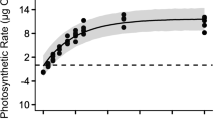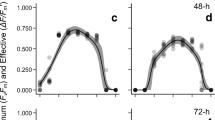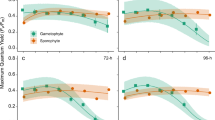Abstract
We examined the effects of four stressors, irradiance, temperature, desiccation, and salinity on the photosynthesis of a red alga, Agarophyton vermiculophyllum (= Gracilaria vermiculophylla, Gracilariales, Rhodophyta) from its native distributional range in Hokkaido and Kagoshima, Japan. Photosynthesis–irradiance (P–E) curves at 8, 16, and 28°C showed that the maximum net-photosynthetic rates (NPmax) and saturation irradiance (Ek) were highest at 28°C for both strains. Gross-photosynthesis determined at 8–40°C at 200 μmol photons m-2 s-1 showed that the maximum gross-photosynthetic rate (GPmax) occurred at 25.3°C for Hokkaido and 28.0°C for Kagoshima (\( {T}_{opt}^{GP} \)), which is almost consistent with the summer-time seawater temperature at each habitat. The temperature responses (4–40°C) of effective quantum yields (ΔF/Fm') of photosystem II during 7-day exposures were similar to that of oxygenic photosynthesis and the optimum temperature (\( {T}_{opt}^{\varDelta F/ Fm\prime } \)) was 20.0°C for Hokkaido and 30.1°C for Kagoshima. In the desiccation experiment, the ΔF/Fm' decreased with decreasing absolute water content (AWC); nevertheless, for samples with an AWC above 20%, ΔF/Fm' retuned to initial levels after subsequent 1-day rehydration in seawater, suggesting relatively strong tolerance to desiccation. This alga also showed a broad range of tolerance to salinity ranging from 20 to 60 psu in 7-day exposures, and the ΔF/Fm' tolerated 0 psu at 3-day exposure. The adaptations of A. vermiculophyllum from its native range in Japan to relatively high irradiance, a broad range of temperature, and strong osmotic (desiccation and salinity) tolerance explain its potentially high invasive capacity.






Similar content being viewed by others
Data availability
The datasets generated in the present study are available from the corresponding author on reasonable request.
References
Alexandrov GA, Yamagata Y (2007) A peaked function for modeling temperature dependence of plant productivity. Ecol Model 200:189–192
Allakhverdiev SI, Kreslavski VD, Klimov VV, Los DA, Carpentier R, Mohanty P (2008) Heat stress: an overview of molecular responses in photosynthesis. Photosynth Res 98:541–550
Allakhverdiev SI, Murata N (2004) Environmental stress inhibits the synthesis de novo of proteins involved in the photodamage-repair cycle of photosystem II in Synechocystis sp. PCC 6803. Biochim Biophys Acta 1657:23–32
Barrett EM (1963) The California oyster industry. Fish Bull 123:1–53
Beer S, Biörk M, Beardall J (2014) Photosynthesis in the marine environment. Wiley-Blackwell, Ames, Iowa
Bellasio C, Burgess SJ, Griffiths H, Hibberd JM (2014) A high throughput gas exchange screen for determining rates of photorespiration or regulation of C4 activity. J Exp Bot 65:3769–3779
Bellorin AM, Oliveira MC, Oliveira EC (2004) Gracilaria vermiculophylla: A western Pacific species of Gracilariaceae (Rhodophyta) first recorded from the eastern Pacific. Phycol Res 52:69–79
Boo SM, Ko YD (2012) Marine plants from Korea. Marine and Extreme Genome Research Centre Program, Seoul (in Korean)
Borlongan IA, Arita R, Nishihara GN, Terada R (2020) The effects of temperature and irradiance on the photosynthesis of two heteromorphic life history stages of Saccharina japonica (Laminariales) from Japan. J Appl Phycol 32:4175–4187
Bürkner PC (2018) Advanced Bayesian multilevel modeling with the R Package brms. R J 10:395–411
Byers JE, Gribben PE, Yeager C, Sotka EE (2012) Impacts of an abundant introduced ecosystem engineer within mudflats of the southeastern US coast. Biol Invasions 149:2587–2600
Contreras-Porcia L, Thomas D, Flores V, Correa JA (2011) Tolerance to oxidative stress induced by desiccation in Porphyra columbina (Bangiales, Rhodophyta). J Exp Bot 62:1815–1829
Dan A, Hiraoka M, Ohno M, Critcheley AT (2002) Observations on the effect of salinity and photon fluence rate on the induction of sporulation and rhizoid formation in the green alga Enteromorpha prolifera (Müller) J. Agardh (Chlorophyta, Ulvales). Fish Sci 68:1182–1188
Davison IR, Peason GA (1996) Stress tolerance in intertidal seaweeds. J Phycol 32:197–211
Dring MJ, Brown FA (1982) Photosynthesis of intertidal brown algae during and after periods of emersion: a renewed search for physiological causes of zonation. Mar Ecol Prog Ser 8:301–308
Flores-Molina MR, Thomas D, Lovazzanoc C, Núñez A, Zapata J, Kumar M, Correa JA, Contreras-Porcia L (2014) Desiccation stress in intertidal seaweeds: Effects on morphology, antioxidant responses and photosynthetic performance. Aquat Bot 113:90–99
Freshwater DW, Greene JK, Hamner RM (2006a) Seasonality of the invasive seaweed Gracilaria vermiculophylla along the southeastern coast of North Carolina. J North Carolina Acad Sci 122:49–55
Freshwater DW, Montgomery F, Greene JK, Hammer RM, Williams M, Whitfield PE (2006b) Distribution and identification of an invasive Gracilaria species that is hampering commercial fishing operations in southeastern North Carolina, USA. Biol Invasions 8:631–637
Gao S, Niu J, Chen W, Wang G, Xie X, Pan G, Gu W, Zhu D (2013) The physiological links of the increased photosystem II activity in moderately desiccated Porphyra haitanensis (Bangiales, Rhodophyta) to the cyclic electron flow during desiccation and re-hydration. Photosynth Res 116:45–54
Gao S, Shen S, Wang G, Niu J, Lin A, Pan G (2011) PSI-driven cyclic electron flow allows intertidal macro-algae Ulva sp. (Chlorophyta) to survive in desiccated conditions. Plant Cell Physiol 52:885–893
Gao S, Wang G (2012) The enhancement of cyclic electron flow around photosystem I improves the recovery of severely desiccated Porphyra yezoensis (Bangiales, Rhodophyta). J Exp Bot 63:4349–4358
Gelman A (2004) Parameterization and Bayesian Modeling. J Am Stat Assoc 99:537–545
Gelman A (2006) Prior distributions for variance parameters in hierarchical models. Bayesian Anal 1:515–533
Gorman L, Kraemer GP, Yarish C, Boo SM, Kim JK (2017) The effects of temperature on the growth rate and nitrogen content of invasive Gracilaria vermiculophylla and native Gracilaria tikvahiae from Long Island Sound, USA. Algae 32:57–66
Gurgel CFD, Norris JN, Schmidt WE, Le HN, Fredericq S (2018) Systematics of the Gracilariales (Rhodophyta) including new subfamilies, tribes, subgenera, and two new genera, Agarophyton gen. nov. and Crassa gen. nov. Phytotaxa 374:1–23
Hammann M, Buchholz B, Karez R, Weinberger F (2013a) Direct and indirect effects of Gracilaria vermiculophylla on native Fucus vesiculosus. Aquat Invasions 8:121–132
Hammann M, Wang G, Rickert E, Boo SM, Weinberger F (2013b) Invasion success of the seaweed Gracilaria vermiculophylla correlates with low palatability. Mar Ecol Prog Ser 486:93–103
Henley WJ (1993) Measurement and interpretation of photosynthetic light-response curves in algae in the context of photo inhibition and diel changes. J Phycol 29:729–739
Holzinger A, Karsten U (2013) Desiccation stress and tolerance in green algae: consequences for ultrastructure, physiological, and molecular mechanisms. Front Plant Sci 4:327
Hurd CL, Harrison PJ, Bischof K, Lobban CS (2014) Seaweed ecology and physiology, 2nd edn. Cambridge University Press, Cambridge
Jassby AD, Platt T (1976) Mathematical formulation of the relationship between photosynthesis and light for phytoplankton. Limnol Oceanogr 21:540–547
Ji Y, Tanaka J (2002) Effect of desiccation on the photosynthesis of seaweeds from the intertidal zone in Honshu, Japan. Phycol Res 50:145–153
Kim KY, Garbary DJ (2007) Photosynthesis in Codium fragile (Chlorophyta) from a Nova Scotia estuary: responses to desiccation and hyposalinity. Mar Biol 151:99–107
Kim SY, Weinberger F, Boo SM (2010) Genetic data hint at a common donor region for invasive Atlantic and Pacific populations of Gracilaria vermiculophylla (Gracilariales, Rhodophyta). J Phycol 46:1346–1349
Kirst GO (1989) Salinity tolerance of eukaryotic marine algae. Annu Rev Plant Physiol Plant Mol Biol 41:21–53
Kokubu S, Nishihara GN, Watanabe Y, Tsuchiya Y, Amano Y, Terada R (2015) The effect of irradiance and temperature on the photosynthesis of a native brown alga, Sargassum fusiforme (Fucales) from Kagoshima, Japan. Phycologia 54:235–247
Krueger-Hadfield SA, Kollars NM, Byers JE, Greig TW, Hammann M, Murray DC, Murren CJ, Strand AE, Terada R, Weinberger F, Sotka EE (2016) Invasion of novel habitats uncouples haplo-diplontic life cycles. Mol Ecol 25:3801–3816
Krueger-Hadfield SA, Kollars NM, Strand AE, Byers JE, Shainker SJ, Terada R, Greig TW, Hammann M, Murray DC, Weinberger F, Sotka EE (2017) Genetic identification of source and likely vector of a widespread marine invader. Ecol Evol 7:4432–4447
Maggi E, Benedetti-Cecchi L, Castelli A, Chatzinikolaou E, Crowe TP, Ghedini G, Kotta J, Lyons DA, Ravaglioli C, Rilov G, Rindi L, Bulleri F (2015) Ecological impacts of invading seaweeds: a meta-analysis of their effects at different trophic levels. Divers Distrib 21:1–12
Martínez-Lüscher J, Holmer M (2010) Potential effects of the invasive species Gracilaria vermiculophylla on Zostera marina metabolism and survival. Mar Environ Res 69:345–349
Martins I, Oliveira JM, Flindt MR, Marques JC (1999) The effect of salinity on the growth rate of the macroalgae Enteromorpha intestinalis (Chlorophyta) in the Mondego estuary (west Portugal). Acta Oecol 20:259–265
Nejrup LB, Pedersen MF (2012) The effect of temporal variability in salinity on the invasive red alga Gracilaria vermiculophylla. Eur J Phycol 47:254–263
Nejrup LB, Staehr PA, Thomsen MS (2013) Temperature- and light-dependent growth and metabolism of the invasive red algae Gracilaria vermiculophylla – a comparison with two native macroalgae. Eur J Phycol 48:295–308
Ohmi H (1956) Contributions to the knowledge of Gracilariaceae from Japan. II. On a new species of the genus Gracilariopsis with some considerations on its ecology. Bull Fac Fish Hokaido Univ 6:271–279
Ohmi H (1958) The species of Gracilaria and Gracilariopsis from Japan and adjacent waters. Mem Fac Fish Hokkaido Univ 6:1–66
Ohno M, Largo DB (1998) The seaweed resources of Japan. In: Critchley AT, Ohno M (eds) Seaweed resources of the world. Japan International Cooperation Agency, Kanagawa, pp 1–14
Phooprong S, Ogawa H, Hayashizaki K (2008) Photosynthetic and respiratory responses of Gracilaria vermiculophylla (Ohmi) Papenfuss collected from Kumamoto, Shizuoka and Iwate, Japan. J Appl Phycol 20:743–750
Platt T, Gallegos CL, Harrison WG (1980) Photoinhibition of photosynthesis in natural assemblages of marine phytoplankton. J Mar Res 38:687–701
R Development Core Team (2020) R: A language and environment for statistical computing. R Foundation for Statistical Computing, Vienna. http://www.R-project.org (acessed on 10 December 2020)
Raikar SV, Iima M, Fujita Y (2001) Effect of temperature, salinity and light intensity on the growth of Gracilaria spp. (Gracilariales, Rhodophyta) from Japan, Malaysia and India. Indian J Mar Sci 30:98–104
Roleda MY (2009) Photosynthetic response of Arctic kelp zoospores exposed to radiation and thermal stress. Photochem Photobiol Sci 9:1302–1312
Ruesink JL, Lenihan HS, Trimble AC, Heiman KW, Micheli F, Byers JE, Kay MC (2005) Introduction of non-native oysters: ecosystem effects and restoration implications. Annu Rev Ecol Evol Syst 36:643–689
Rueness J (2005) Life history and molecular sequences of Gracilaria vermiculophylla (Gracilariales, Rhodophyta), a new introduction to European waters. Phycologia 44:120–128
Saunders GW (2009) Routine DNA barcoding of Canadian Gracilariales (Rhodophyta) reveals the invasive species Gracilaria vermiculophylla in British Columbia. Mol Ecol Resour 9:140–150
Sotka EE, Baumgardner AW, Bippus PM, Destombe C, Duermit EA, Endo H, Flanagan BA, Kamiya M, Lees LE, Murren CJ, Nakaoka M, Shainker SJ, Strand AE, Terada R, Valero M, Weinberger F, Krueger-Hadfield SA (2018) Combining niche shift and population genetic analyses predicts rapid phenotypic evolution during invasion. Evol Appl 11:781–793
Stan Development Team (2020) Stan: A C++ Library for Probability and Sampling, Version 2.18.9. http://mc-stan.org (Acessed on 10 April 2020)
Takahashi S, Murata N (2008) How do environmental stresses accelerate photoinhibition? Trends Plant Sci 13:178–182
Tcherkez G, Bligny R, Gout E, Mahé A, Hodges M, Cornic G (2008) Respiratory metabolism of illuminated leaves depends on CO2 and O2 conditions. Proc Natl Acad Sci U S A 105:797–802
Terada R, Abe M, Abe T, Aoki M, Dazai A, Endo H, Kamiya M, Kawai H, Kurashima A, Motomura T, Murase N, Sakanishi Y, Shimabukuro H (2021) Japan’s nationwide long-term monitoring survey of seaweed communities known as the “Monitoring Sites 1000”: Ten-year overview and future perspectives. Phycol Res 69:12–30
Terada R, Abe T, Kawaguchi S (2010) Reproductive phenology of three species of Gracilaria: G. blodgettii Harvey, G. vermiculophylla (Ohmi) Papenfuss and G. salicornia (C. Agardh) Dawson (Gracilariales, Rhodophyta) from Okinawa, Ryukyu Islands, Japan. Coast Mar Sci 34:129–134
Terada R, Kimura M, Yamamoto H (2000) Growth and maturation of Gracilaria vermiculophylla (Ohmi) Papenfuss from Hakodate, Hokkaido, Japan. Jpn J Phycol 48:203–209 (in Japanese with English abstract)
Terada R, Nakashima Y, Borlongan IA, Shimabukuro H, Kozono J, Endo H, Shimada S, Nishihara GN (2020a) Photosynthetic activity including the thermal- and chilling-light sensitivities of a temperate Japanese brown alga Sargassum macrocarpum. Phycol Res 68:70–79
Terada R, Nakazaki Y, Borlongan IA, Endo H, Nishihara GN (2018) Desiccation effect on the PSII photochemical efficiency of cultivated Japanese Caulerpa lentillifera under the shipping package environment. J Appl Phycol 30:2533–2588
Terada R, Yamamoto H (2002) Review of Gracilaria vermiculophylla (Ohmi) Papenfuss and other species in Japan and Asia. In: Abbott IA, McDermid K (eds) Taxonomy of economic seaweeds, with special reference to Pacific species Volume 8. California Sea Grant College Program, University of California, La Jolla, pp 225–230
Terada R, Yuge T, Watanabe Y, Mine T, Morikawa T, Nishihara GN (2020b) Chronic effects of three different stressors, irradiance, temperature, and desiccation on the PSII photochemical efficiency in the heteromorphic life-history stages of cultivated Pyropia yezoensis f. narawaensis (Bangiales) from Japan. J Appl Phycol 32:3273–3284
Titlyanov EA, Titlyanova TV (2012) Marine plants of the Asian Pacific region countries, their use and cultivation. A.V. Zhirmunsky Institute of Marine Biology Ear East Branch of the Russian Academy of Sciences, Dalnauka, Vladivostok
Thomsen MS, Gurgel CFD, Fredericq S, McGlathery KJ (2006) Gracilaria vermiculophylla (Rhodophyta, Gracilariales) in Hog Island Bay, Virginia: a cryptic alien and invasive macroalga and taxonomic correction. J Phycol 42:139–141
Thomsen MS, McGlathery KJ, Schwarzschild A, Silliman BR (2009) Distribution and ecological role of the non-native macroalga Gracilaria vermiculophylla in Virginia salt marshes. Biol Invasions 11:2303–2316
Thomsen MS, Staehr PA, Nyberg CD, Schwærter S, Krause-Jensen D, Silliman BR (2007) Gracilaria vermiculophylla (Ohmi) Papenfuss, 1967 (Rhodophyta, Gracilariaceae) in northern Europe, with emphasis on Danish conditions, and what to expect in the future. Aquat Invasions 2:83–94
Thornley JHM, Johnson IR (2000) Plant and Crop Modelling: A mathematical approach to plant and crop physiology. Blackburn Press, Caldwell, NJ
Tseng CK, Xia BM (1999) On the Gracilaria in the Western Pacific and the Southeastern Asia Region. Bot Mar 42:209–217
Wallentinus I, Nyberg CD (2007) Introduced marine organisms as habitat modifiers. Mar Pollut Bull 55:323–332
Wang WJ, Wang FJ, Zhu JY, Sun XT, Yao CY, Xu P (2011) Freezing tolerance of Porphyra yezoensis (Bangiales, Rhodophyta) gametophyte assessed by chlorophyll fluorescence. J Appl Phycol 23:1017–1022
Watanabe Y, Nishihara GN, Tokunaga S, Terada R (2014) The effect of irradiance and temperature responses and the phenology of a native alga, Undaria pinnatifida (Laminariales), at the southern limit of its natural distribution in Japan. J Appl Phycol 26:2405–2415
Watanabe Y, Yamada H, Mine Y, Kawamura Y, Nishihara GN, Terada R (2017) Chronological change and the potential of recovery on the photosynthetic efficiency of Pyropia yezoensis f. narawaensis (Bangiales) during the sporelings frozen storage treatment in the Japanese Nori cultivation. Phycol Res 65:265–271
Webb WL, Newton M, Starr D (1974) Carbon dioxide exchange of Alnus rubra: a mathematical model. Oecologia 17:281–291
Weinberger F, Buchholz B, Karez R, Wahl M (2008) The invasive red alga Gracilaria vermiculophylla in the Baltic Sea: adaptation to brackish water may compensate for light limitation. Aquat Biol 3:251–264
Wiltens J, Schreiber U, Vidaver W (1978) Chlorophyll fluorescence induction: an indicator of photosynthetic activity in marine algae understanding desiccation. Can J Bot 56:2787–2794
Williams SL, Smith J (2007) A global review of the distribution, taxonomy, and impacts of introduced seaweeds. Annu Rev Ecol Evol Syst 38:327–359
Yamamoto H (1978) Systematic and anatomical study of the genus Gracilaria in Japan. Mem Fac Fish Hokkaido Univ 25:97–152
Yokoya NS, Kakita H, Obika H, Kitamura T (1999) Effects of environmental factors and plant growth regulators on growth of the red alga Gracilaria vermiculophylla from Shikoku Island, Japan. Hydrobiologia 398:339–347
Acknowledgements
We thank colleague and lab mates, Hikaru Endo, Iris Ann Borlongan (present: University of the Philippines Visayas), Jumpei Kozono (present: Japan Wildlife Research Center) for their kind assistance in the present study. All authors have provided consent.
Funding
This research was supported in part by the Grant-in-Aid for Scientific Research (B; #16H02939, #20H03076) from Japan Society for the Promotion of Science (JSPS).
Author information
Authors and Affiliations
Corresponding author
Additional information
Publisher’s note
Springer Nature remains neutral with regard to jurisdictional claims in published maps and institutional affiliations.
Rights and permissions
About this article
Cite this article
Kameyama, R., Nishihara, G.N., Kawagoe, C. et al. The effects of four stressors, irradiance, temperature, desiccation, and salinity on the photosynthesis of a red alga, Agarophyton vermiculophyllum (Gracilariales) from a native distributional range in Japan. J Appl Phycol 33, 2561–2575 (2021). https://doi.org/10.1007/s10811-021-02469-1
Received:
Revised:
Accepted:
Published:
Issue Date:
DOI: https://doi.org/10.1007/s10811-021-02469-1




